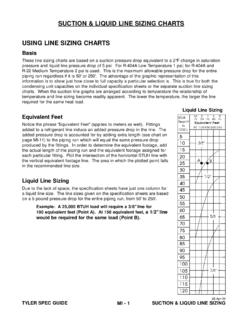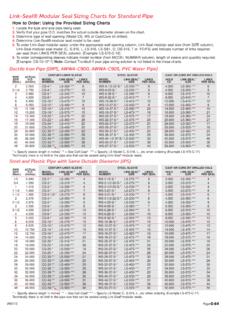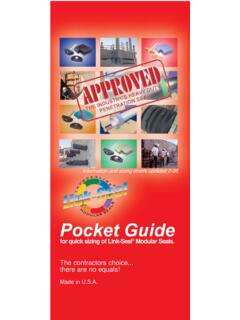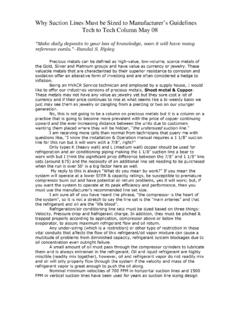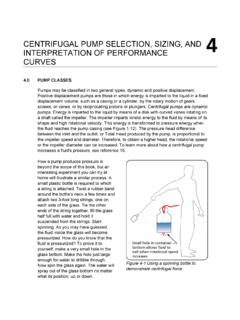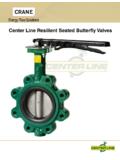Transcription of Sizing Domestic Water Pipes S - …
1 Some plumbers successfully sizeresidential supply Pipes basedon long experience or rules ofthumb. But in unusual circum-stances when a house has low pressure, long pipe runs, an extensiveirrigation system, or a large whirlpooltub rules of thumb may result inundersized Pipes that perform poorlyor don t meet code (see Figure 1, nextpage). To accurately size residential watersupply Pipes , you need to have infor-mation on six important variables: code requirements available minimum static pressure atthe Water meter or pressure tank the pressure-reducing effect of anywater meter, backflow preventer, Water softener, and/or whole-housefilter length of pipe to the most remotefixture in the building height of the building Water demand, expressed in supplyfixture units or gallons per minuteOnce these six factors are known, pipe sizes can be determined by sim-ple tables.
2 In creating these tables,engineers have considered several fac-tors, including the need to limit watervelocity. (When Water velocity exceedsabout 8 feet per second, it can be noisyMARCHJLC2002by Richard ZanniniSizingDomestic Water PipesSizingDomestic Water PipesFor long runs and tallhouses remember touse larger supply pipesCAROLYN BATESand can cause erosion of the pipe .)Using the tables ensures that even atthe end of a long pipe run, a mini-mum pressure of 8 or 10 psi will beavailable at each fixture.
3 (Flushometervalves, which are typically found onlyin commercial buildings, requirebetween 15 and 25 psi at the fixturefor proper operation.)Know Your Local CodeRegardless of the method used tosize your Pipes , local codes must befollowed. Some codes have specificrequirements that overrule engineer-ing calculations for example, therequirement that a Water service pipemust be no smaller than 3/4inch, orthat a 1/2-inch pipe can serve no morethan four codes stipulate a minimumpipe diameter for each type of fixture;in almost all cases, that minimum is1/2inch.
4 There are a few exceptions,however: Some codes permit the use of3/8-inch pipe for lavatories, bidets, andtoilets; and others permit the use of3/8-inch PEX in a manifold system. Aflushometer valve will always require apipe size greater than 1 every code, including theBOCA National Plumbing Code, theSBCCI Standard Plumbing Code, theUBC Uniform Plumbing Code, theCalifornia Plumbing Code, and the IBCI nternational Residential Code, has asection specifying the method to beused for Sizing supply Pipes , and thecodes do not always agree.
5 Your localcode, as interpreted by your inspector,trumps all other opinions and sizingmethods. PressureThere are two kinds of pressure: sta-tic pressure, which is measured whenno Water is flowing, and dynamicpressure, which is measured whenwater is flowing. When measured at afixture, both the dynamic and the sta-tic pressure are likely to be less thanthe static pressure measured at themeter or pressure tank. The drop inpressure is due to friction as waterflows through equipment, pipe , andfittings, and to the static loss in pres-sure from raising the Water to a and maximum pres-sures.
6 Most codes require residentialstatic Water pressure to be between 40and 80 psi. The pressure provided by amunicipal Water system may be eithertoo low or too high. Where I work, inManchester, , the municipalwater pressure varies from neighbor-hood to neighborhood, from a low ofabout 45 psi to a high of 130 psi. If themunicipal pressure is higher than 80psi, most codes require the installationof a pressure-reducing valve to knockthe pressure down to 80 psi. Although the 1993 BOCA NationalPlumbing Codepermits residential sta-tic pressure to be as low as 30 psi, the2000 International Residential Code(IRC) requires a minimum of 40 psi.
7 Inareas where the municipal pressure istoo low, the solution is to install abooster pump and pressure tank. To size the Pipes , you can measurethe static pressure directly with a pres-sure gauge (after the meter and pres-sure-reducing valve), or you cancontact the local utility to ask whatpressure is typical in the neighbor-hood. In areas where the Water pres-sure varies from season to season, usethe lowest value it comes to Sizing Water Pipes ,codes do not make any distinctionbetween systems supplied by munici-pal Water and systems supplied by pri-vate wells.
8 On a rural system, the staticpressure will vary between the cut-inand cut-out settings on the pressureswitch controlling the pump typi-cally 45 to 60 psi. To size the pipe , usethe minimum pressure (45 psi). Pressure losses from types of equipment, includingwater meters, backflow preventers, Water filters, and Water softeners,introduce friction that results indynamic pressure loss. It s yourresponsibility to contact the manufac-turer of any such equipment to obtainpressure loss information.
9 For exam-ple, a 3/4-inch Watts #7 backflow pre-venter creates a friction loss of 4 psi at12 gpm ( feet per second). Watersoftener and whole-house filter manu-facturers rate their equipment at dif-ferent flow rates (typically between 5gpm and gpm), with pressure lossratings in the range of 5 to 15 psi,depending on the specific piece ofequipment. Use this information toadjust the available Water loss from used to size the supply pipesMARCHJLC2002 Figure s no surprisethat this homeownerhad Water supply prob-lems.
10 The builder hadinstalled a reducingcoupling on the pres-sure-tank tee, so hecould supply the entirehouse with a 3/8-inchsoft copper line. REX CAULDWELL also needs to be reduced to accountfor the elevation difference betweenthe source and the highest fixture inthe building. This type of pressureloss is called the static pressure loss;even when no Water is flowing, thepressure on the top floor of a multi-story building will be less than thepressure in the basement.
